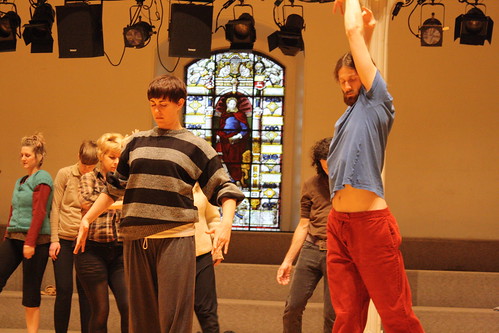 Rachel Ohm Dancers rehearse for this weekend’s continuation of “Body Madness” at Danspace in St. Mark’s Church in the Bowery.
Rachel Ohm Dancers rehearse for this weekend’s continuation of “Body Madness” at Danspace in St. Mark’s Church in the Bowery.As a warm-up, Mariangela Lopez instructs her dancers to walk across the hardwood floor of St. Mark’s Church without music. They begin slowly and as they progress to the opposite end of the room their movements become more pronounced. They stretch and contort their bodies, reaching to the sky and crawling on the floor, moving around and with each other.
When the music finally comes on, they are scattered to different parts of St. Mark’s. One dancer is in the upstairs vestibule, another in the risers on the side, and some are on the floor.
They are preparing for their next performance with the Danspace Project, a contemporary dance studio that has been performing in St. Mark’s Church in the Bowery since 1974, in a space that is also home to poetry and theater projects while still being a practicing Episcopal Church.
Last year Danspace executive director Judy Hussie-Taylor started the Choreographic Center Without Walls, an effort to bring dance curators, choreographers and artists together for a series of performances she calls “platforms”. One year later and the project has become an important part of what Danspace is all about.
The idea began in 2008 when, in the midst of the nationwide economic downturn, Ms. Hussie-Taylor and her staff at Danspace were trying to relocate to a new choreographic and studio space in Brooklyn. She began thinking about ways to reinvigorate the space at St. Mark’s where Danspace had been performing for over 30 years, and although the new studio in Brooklyn was never completed, a new type of dance space at St. Mark’s — the Choreographic Center Without Walls — started.
“I just began thinking about what it means to be a choreographer living in New York City now in this economy and it reminded me that Danspace was founded when New York was on the brink of bankruptcy,” she said. “It was a moment to reflect on what it means to be living downtown or in Brooklyn and trying to make a life in dance.” She says she was concerned that artists would be especially affected by the economy and wanted to offer them the opportunity to continue to create.
She turned to the resources already available at Danspace and artists to whom she wanted to give the opportunity to explore a single idea over the course of a dance season of five or six weeks. “I asked what can I do in the church?” said Ms. Hussie-Taylor. “How can I provide more context for all this work being made?”
The platforms offer residencies for artists, round-table discussions and performances. Danspace has also been documenting each one with catalogues and photographers. Danspace is currently showcasing a platform called “Body Madness,” which last week featured the work of Yvonne Meier, a Swiss-born artist, who directed her dancers with what she called “scores” — directions such as “devour each other elegantly” or “make a knot.” One score was interpreted as the dancer’s decision to move into the audience and kiss The Times’ dance reviewer in her front row seat.
That dancer, Arturo Vidich, has worked with Ms. Meier since 2005 and as part of the PLATFORM 2011 series will also be performing to his own choreography at the end of this week.
“What Yvonne is saying to us in live performance is always a surprise,” he said. “It’s improvisational but it’s also about the timing and tension and withholding. You have to always leave them” – the audience – “wanting something.”
“Improvisational dance is all about friction,” said Ms. Meier. “There is friction between the dance and the music. When I give them” – the artists – “scores sometimes they integrate and sometimes they oppose them.”
She said she loves working in the open space in St. Mark’s Church, the beautifully well-lit interior with white washed walls and stained glass windows, the temporary home of Body Madness.



